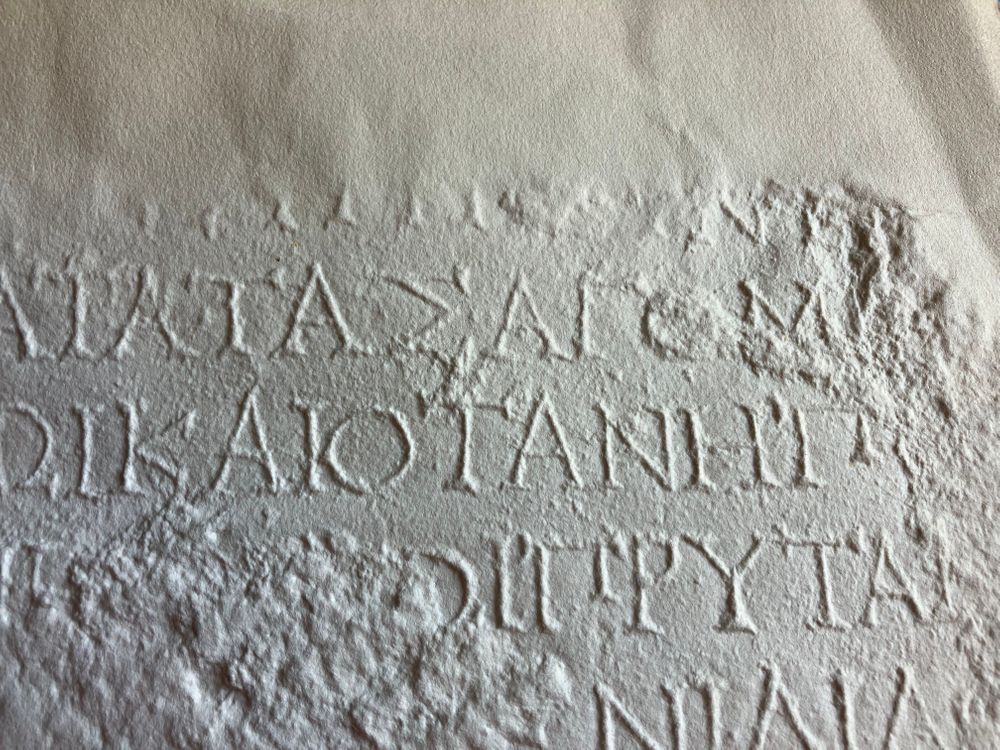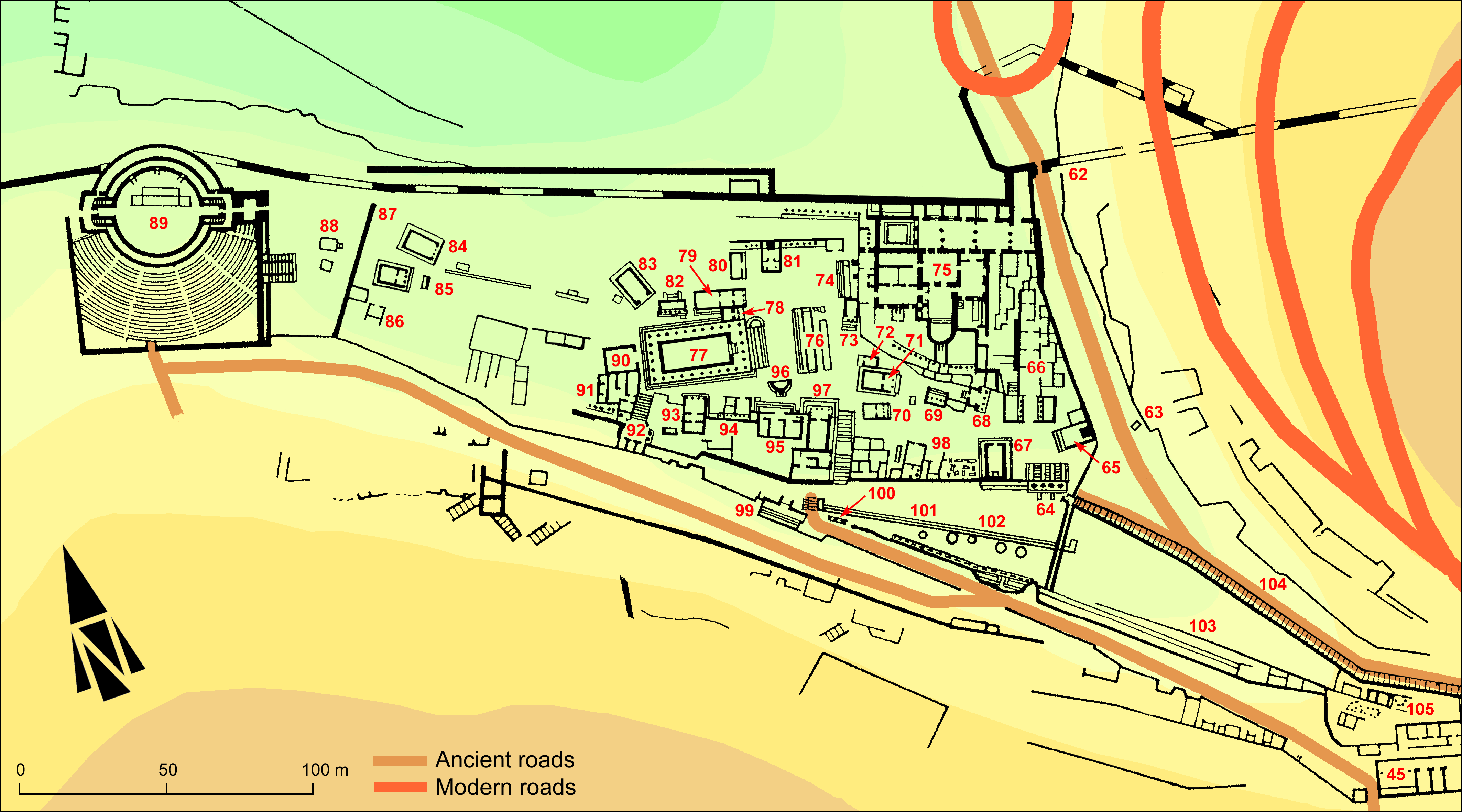Support: Three pieces of a white marble slantering stele: the main fragment (b) re-cut on top for a later use in a curved and
moulded shape, broken off below, chipped off at both sides and partly hammered off on the inscribed face
(w: 0.51-0.54 × h: 0.8 × d: 0.22); .
one small non-adjacent fragment (a) from the left edge of an upper part otherwise lost
(w: 0.04 × h: 0.05 × d: 0.22);
and one small fragment (c) adjacent to the left side of (b)
(w: 0.04 × h: 0.13 × d: 0.22).
Layout: Inscribed on whole width at lines a.1-2 and b.1-13; inscribed on two columns from line 14 on, where
spaces of one line divide the successive groups of entries.
Letters: 0.014, but at lines 47 and 48 of column ii 0.013; carefully cut with serifs, sigma with parallel outer bars, rho with small
loop, wide eta; at line 41 delta as a figure has a line above.
Date: Probably second half of second century BC (lettering).
Findspot: Fragment b: found in 1925 at Cyrene ➚:
Sanctuary of Apollo, near the Temple of Apollo.
Fragments a and c: found in 1928 at Cyrene ➚:
pronaos of the Temple of Hekate.
Place of origin: Findspot.
Last recorded location: Cyrene Museum, 31.
Fragment b only: seen by C. Dobias-Lalou in 1979 in Shahat: Cyrene Museum.
Text constituted from: Transcription from stone and from other editors (CDL).
French translation
[---] le prêtre [---
---] , si ce n'est dans le sanctuaire d'Apollon lors des jours de fêtes fixes en l'honneur du dieu et lorsque le corps civique
se réunit <sous> un portique ou près de (scil. la statue de) Lysis ou que des assemblées de magistrats mangent au prytanée. Défense de remettre un vase à quiconque, que
ce soit la cité, un magistrat en fonction ou un particulier, et d'en emporter un à l'extérieur ou de l'accepter. Défense aussi
de s'en servir à la faveur d'une ruse, d'une tromperie ou d'un prétexte quel qu'il soit. (10) Si quelqu'un contrevient à ces
règles, il sera coupable de sacrilège et exposé à tous les pires malheurs qui frappent les impies.
Ce sont [12] vases à boire : dont un d'un poids de [---] drachmes; (15) un autre de [---] drachmes; un autre de [---] drachmes; un autre de [---] drachmes; un autre de [---] drachmes; un autre de [---] drachmes;(20) un autre de [---] drachmes; un autre de [---] drachmes; un autre de [---] drachmes; un autre de [--- drachmes]; un autre de [--- drachmes]; (25) un autre de [--- drachmes].
Des vases de quatre kotyles, [6]: dont un d'un poids de [--- drachmes]; un autre de [--- drachmes]; un autre de [--- drachmes]; (30) un autre de [--- drachmes]; un autre de [--- drachmes]; un autre de [--- drachmes].
Des vases de trois kotyles: [6, dont un d'un poids de] 138 drachmes; (35) [un autre] de 139; [un autre] d'au moins 140; [un
autre] d'au moins 130; [un autre] d'au moins 140; [un autre] de 138.
(41)[Des vases de deux kotyles?], 4, [dont un d'un poids d'] au moins 90 drachmes; [un autre d'] au moins 90 drachmes; [un
autre de tant]; (45)[un autre de tant] de plus de 80 drachmes.
[Vase] d'un cotyle et demi [---].
[Autre récipient?] de [tant?]. [.. ? ..]cotyles, [3?], (50)[dont un de] 390 drachmes; [un autre] de 370 drachmes; [un autre] de [.]32 drachmes.
English translation
[---] the priest [---]
[---], except in Apollo's sanctuary during the fixed holidays in honour of the god and whenever the civic body meets <under> a
portico or near Lysis' (scil. statue) or whenever assembled magistrates are eating in the prytaneion. Neither the city, nor an officer on duty, nor a private person, should provide a vase to anyone, nor take any outside nor
receive any. Be it forbidden to anyone to use one by whatever trick, deceit or pretext. (10) If anyone should act against
those rules, he will be guilty of sacrilege and should endure the worst calamities that hit impious men.
There are [12] drinking vases: amongst which one, weighing [---] drachmas; (15) another, of [---] drachmas; another, of [---] drachmas; another, of [---] drachmas; another, of [---] drachmas; another, of [---] drachmas; (20) another, of [--- drachmas]; another of [--- drachmas];; another, of [---] drachmas; another, of [--- drachmas]; another, of [--- drachmas]; (25) another of [--- drachmas].
Vases of four kotyles, [6]: amongst which one, weighing [--- drachmas]; another, of [--- drachmas]; another, of [--- drachmas]; another, of [--- drachmas]; (30) another, of [--- drachmas]; another, of [--- drachmas].
Vases of three kotyles: [6, amongst which one weighing] 138 drachmas; (35) [another], of 139; [another], of at least 140;
[another], of at least 130; [another], of at least 140; [another], of 138.
(41)[Vases of two kotyles], 4: [amongst which one weighing] at least 90; [another], of at least 90; [------], [---], (45) [weight] at least 80 drachmas
Vase of[---] one cotyle and a half, [---].
[Other vessel of so much?]. [.. ? ..]cotyles, [3?]: (50)[amongst which one weighing] 390 drachmas; [another], of 370 drachmas; [another], of [.]32 drachmas.
Italian translation
[---] il sacerdote [---
---], tranne che nel santuario di Apollo durante i giorni di festa fissati in onore del dio e quando il corpo civico si raduni
<in> un portico o presso (scil. la statua di) Lysis oppure quando i magistrati riuniti mangino nel prytaneion. Che né la città né alcun magistrato in carica né un privato fornisca alcuna coppa a nessuno, o ne porti una fuori o ne prenda
una. Che nessuno ne faccia uso con qualche inganno o frode o qualsivoglia pretesto. (10) Se qualcuno agisce contro queste
regole, sarà colpevole di sacrilegio ed esposto alle peggiori calamità che colpiscono gli uomini empi.
Ci sono [12] coppe per bere: di cui una, del peso di [---] dracme; (15) un'altra, di [---] dracme; un'altra, di [---] dracme; un'altra, di [---] dracme; un'altra, di [---] dracme; un'altra, di [---] dracme; (20) un'altra, di [---] dracme; un'altra, di [---] dracme; un'altra, di [--- dracme]; un'altra, di [--- dracme]; un'altra, di [--- dracme]; (25) un'altra, di [---] dracme.
Coppe da quattro cotili, [6]: di cui una del peso di [--- dracme]; un'altra, di [--- dracme]; un'altra, di [--- dracme]; (30) un'altra, di [--- dracme]; un'altra, di [--- dracme]; un'altra, di [--- dracme].
Coppe da tre cotili, [6]: [di cui una del peso di] 138 dracme; (35) [un'altra], di 139; [un'altra], di almeno 140; [un'altra],
di almeno 130; [un'altra], di almeno 140; [un'altra], di 138 dracme.
(41)[Coppe da due cotili], 4: [di cui una del peso] di almeno 90 dracme; [un'altra], di almeno 90 dracme; [un'altra, del peso
dic. 1 - 2]; (45) [un'altra], di almeno 80 dracme.
[Coppa] da una cotile e mezzo [---].
[Un altro vaso, del peso di?]. [---]cotili, [3?]: (50) [ di cui una, di] 390 dracme; [un'altra], di 370 dracme; [un'altra], di [.]32 dracme.



